Pierre Ambroise Richebourg, 1810 - 1875
by Brian Stevenson
last updated December, 2024
Pierre Richebourg was initially an employee of Vincent Chevalier (1770-1841), a significant Parisian inventor and manufacturer of microscopes and other optical apparatus. Richebourg acquired his employer’s business after the older man’s death, and long referred to himself as Vincent Chevalier’s student and sole heir to his business. That was an advertising spin to counter efforts by Vincent’s son, Charles Chevalier (1804-1859), who had left his father’s business in 1833 to run his own shop but nonetheless claimed to be Vincent’s business heir.
A small number of microscopes are known that bear Richebourg’s name (Figures 1-4). Duplicates are not known. Most resemble instruments known to be manufactured by other businesses. Additionally, a contemporary biography noted that Richebourg’s efforts turned to photography during the late 1830s, when he studied with Louis Daguerre (1787-1851), and exhibited only as a photographer after 1844. Thus, it is likely that most, if not all, microscopes with Richebourg’s name were acquired by him on the wholesale market, then retailed as a minor component of his inventory.
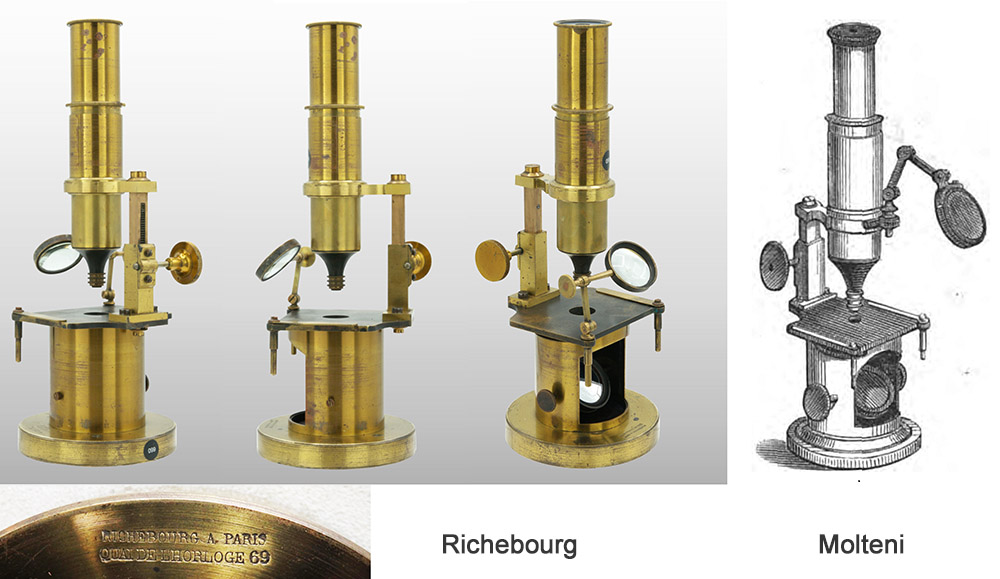
Figure 1.
A drum-style microscope that is stamped with Richebourg’s name and pre-1850 address of 69 Quai de l’Horloge, alongside an engraving from the 1859 catalogue of Molteni & Company, a major Parisian manufacturer of microscopes and other optical instruments. Several other examples of this model are known, which bear signatures of other retailers or are unsigned. Microscope images adapted with permission from https://histoiredumicroscope.com/99-richebourg-pierre-ambroise-1842/.
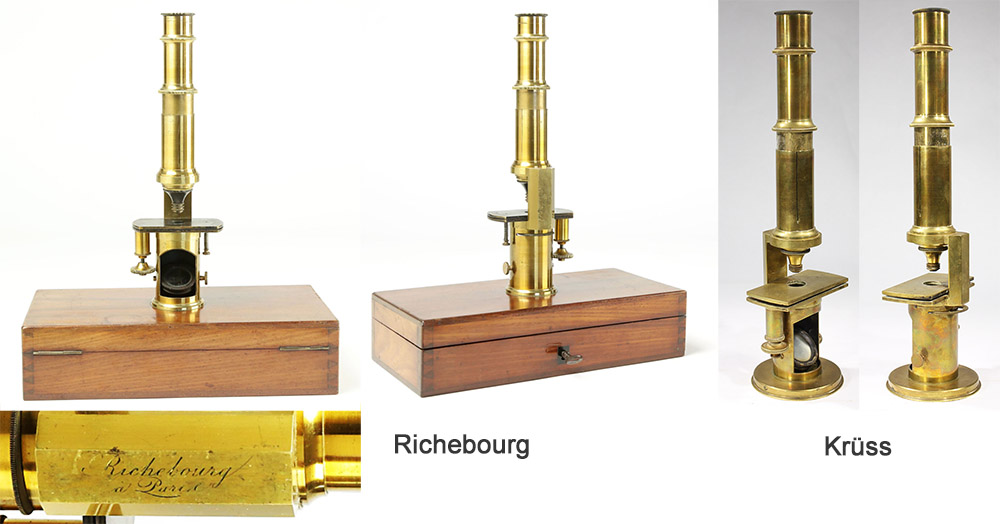
Figure 2.
Smaller drum-style microscopes. The left example is engraved “Richebourg a Paris”. It is almost identical to the “Modell Oberhaeuser” microscopes that were manufactured by A. Krüss in Berlin. Images from the author’s collection or adapted for nonprofit, educational purposes from an internet auction site.
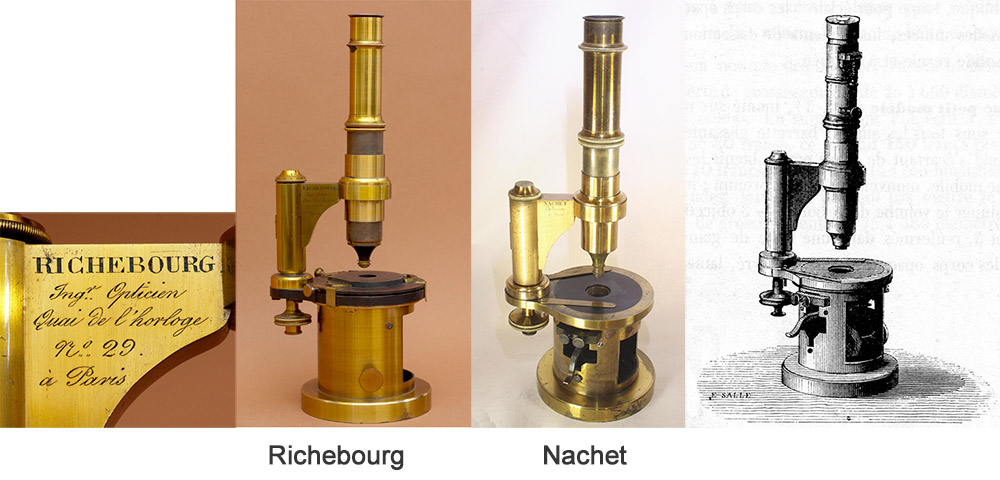
Figure 3.
A large drum-style microscope engraved with Richebourg’s name and post 1850 address of 29 Quai de l’Horloge (left two images), which is nearly identical to the mid-1850s Nachet “Grand Modelle” (right two images – furthest right from Nachet’s 1856 catalogue). Images adapted by permission from https://microscope-antiques.com/nachetdrum2.html or for nonprofit, educational purposes from https://golubcollection.berkeley.edu/19th/315.html.
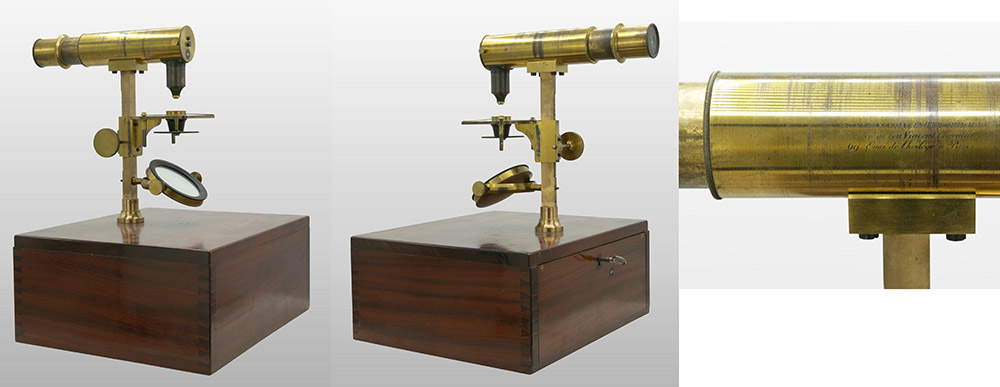
Figure 4.
A horizontal, Amici-style microscope that is engraved with Richebourg’s pre-1850 address of 69 Quai de l’Horloge. Adapted with permission from https://histoiredumicroscope.com/richebourg-pierre-ambroise-1843-inv-473/.
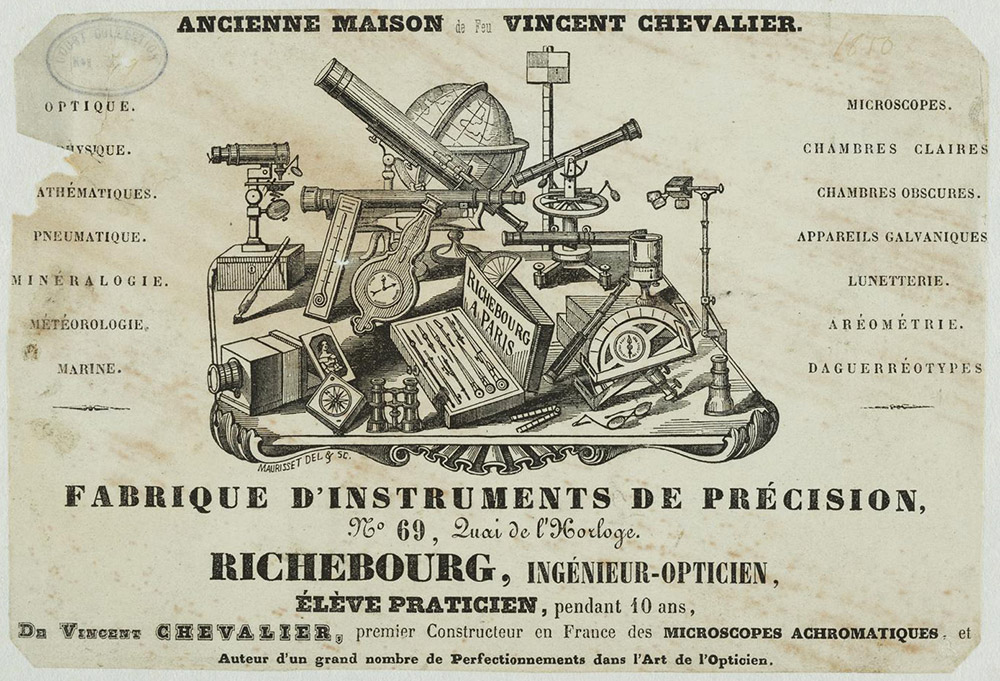
Figure 5.
Early trade label of Pierre Richebourg. Adapted for nonprofit, educational purposes from https://collection.sciencemuseumgroup.org.uk/people/cp129236/richebourg.
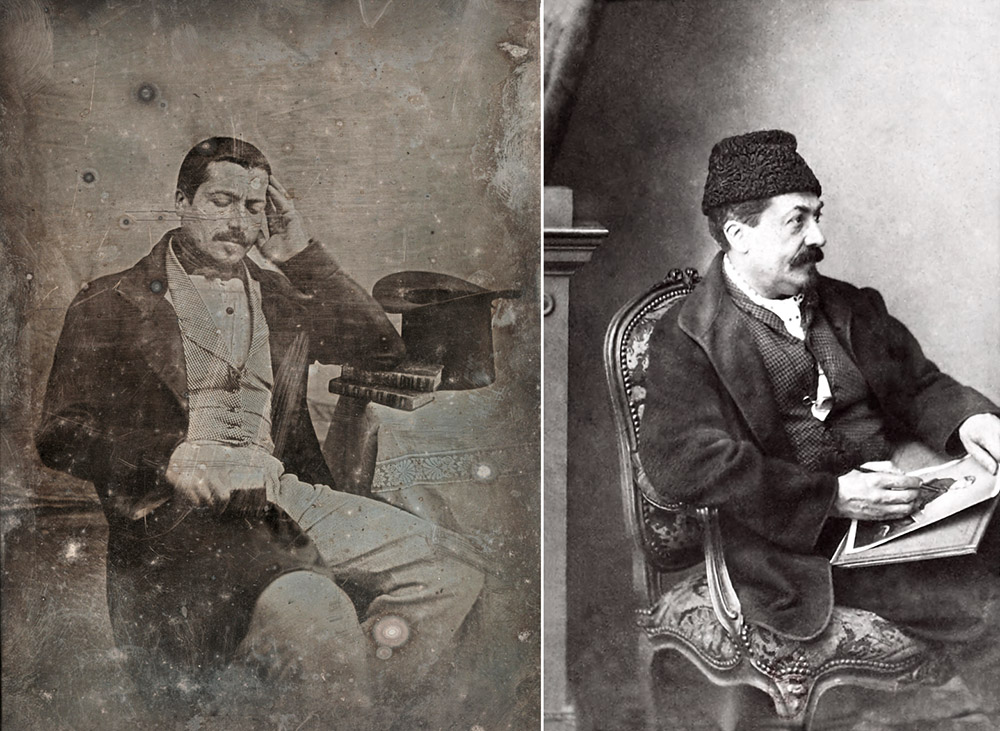
Figure 6.
Self-portraits of Pierre Ambroise Richebourg. Left, daguerréotype taken on July 1, 1841. Right, undated photograph.
Pierre Ambroise Richebourg was born on November 28, 1810, in Paris. In an advertisement, he stated that he worked with Vincent Chevalier for ten years, indicating that he started there in 1831 (Figure 7).
Vincent Chevalier's shop was located at 69 Quai de l’Horloge. Vincent and his son, Charles, became partners around 1826, as “Vincent Chevalier aîné et fils”. Charles left in 1833, opening an independent shop at 163 Palais Royal.
Richebourg (and possibly Vincent Chevalier) began studying photographic processes with Louis Daguerre in about 1838.
After Vincent Chevalier died on November 29, 1841, Richebourg assisted with the inventory of his former employer’s business effects, “Pierre Ambroise Richebourg, employé de la maison Chevalier, demeurant 10, place Maubert assiste à la prisée du matériel en qualité de témoin” (“Pierre Ambroise Richebourg, employee of the Chevalier business, residing at 10 Place Maubert, attended the collection of the material as a witness”). A legal description of the inventory process noted that Vincent Chevalier’s business had largely consisted of photographic apparatus, "le détail de l'atelier d'opticien au travers de 225 références de matériels et objets dont beaucoup sont liés à la daguerréotypie. ... Un ancien appareil de Daguerre, sans tête avec boite au mercure, le tout en bois noirci ... un appareil de daguerréotype sans sa tête renfermé dans une caisse ensemble ses accessoires boite et plaques, divers boites se rattachant au daguerréotype, quatre chaises, deux appareils pour tenir la tête…” (“details of the optician's workshop through 225 references to materials and objects, many of which are linked to daguerreotype. ... An old Daguerre camera, headless with mercury box, all in blackened wood ... a daguerreotype camera without its head enclosed in a box together with its accessories, box and plates, various boxes related to the daguerreotype, four chairs, two devices for holding the head…”).
Richebourg purchased the shop at 69 Quai de l’Horloge and its contents. Throughout his career, he referred to himself as “le seul élève de Vincent Chevalier” (“the only student of Vincent Chevalier”) (Figure 8). Meanwhile, Charles Chevalier touted his family relationship and described himself as the “seul successor de feu Vincent Chevalier” (“only successor to the late Vincent Chevalier”).
In 1843, Richebourg published Nouveau Manuel Complémentaire Pour l'Usage Pratique du Daguerréotype (“New Complementary Manual for the Practical Use of the Daguerreotype”).
He exhibited in the 1844 Produits de l’Industrie Française, earning an Honorable Mention for “instruments d'optique et d'arpentage” (“optical and surveying instruments”). Gustave Vapereau wrote that this was the last occasion at which Richebourg exhibited optical apparatus, and thereafter showed only photographic devices and images.
Nonetheless, Richebourg sold a wide variety of scientific and engineering apparatus at his shop, as did other “opticians” of the time. Many of those items were probably not actually manufactured by Richebourg, who would not have had the space or skilled workforce to create such diversity. Like many other retailers, though, he probably put his name on many of the products that he acquired wholesale and then sold from his shop. Being an expert photographer, it is likely that Richebourg did produce camera lenses and associated apparatus. As examples, the 1847 Annuaire Général du Commerce, de l'Industrie, de la Magistrature included these advertisements (translated):
“Richebourg, private pupil and supplier of Mr. Daguerre, sole executor with the late Vincent Chevalier, the first to straighten images a Daguerre camera (in 1839), as well as of the reproduction of microscopic objects that were presented to the Institute in 1840; author of several editions of elementary and complementary manuals on the subject; builds all perfected devices, and personally demonstrates their use, fabricates and furnishes accessories separately, also does portraits; Demonstration, factory and store at q. de l'Horloge, 69"
“Richebourg, student practitioner for ten years of the late Vincent Chevalier, manufactures perfected and simplified achromatic microscopes; solar microscopes; new cameras lucida; cameras obscura with meniscus prisms by Vincent Chevalier; field, marine, or fancy telescopes; ophthalmic glasses; binoculars for the theater; compasses; mineralogical instruments of Lebaillif and Berzélius; hygrometers; hematometers; and builds all optical, physical, mathematical, meteorological instruments, etc.; specializing in all new or improved devices relating to normal or affected vision, thin glasses of all systems for corrective glasses, neutral tint glasses, as adopted by the late Doctor Sanson the elder and advised by all of the Faculty's learned oculists; builder of barometers, thermometers, hydrometers and generally all that relates to arts and sciences, supplies the cabinets of physics, sends abroad; factory and store q. de l'Horloge, 69”.
The shops on Quai de l’Horloge were renumbered between 1847 and 1850, so that the addresses on items sold by Richebourg are useful for dating them. This was documented when Richebourg renewed his lease in 1850, “Bail pour douze ans, par Louis Oudot, propriétaire, demeurant 40, rue du Cherche-Midi, à Pierre Ambroise Richebourg, ingénieur opticien, et Rose Séraphine Mollier-Gozé, son épouse, demeurant 29, quai de l'Horloge (ancien 69) de caves, boutique en rez-de-chaussée, logements à l'entresol, au premier et cinquième étage et divers lieux dépendant d'une maison située 29, quai de l'Horloge comprenant. Loyer annuel de 2 000 francs, payable par trimester”. (“Lease for twelve years, by Louis Oudot, owner, residing at 40, rue du Cherche-Midi, to Pierre Ambroise Richebourg, engineer optician, and Rose Séraphine Mollier-Gozé, his wife, residing at 29, quai de l'Horloge (former 69), including cellars, shop on the ground floor, accommodation on the mezzanine, on the first and fifth floors and various places depending on a house located at 29, quai de l'Horloge. Annual rent of 2,000 francs, payable quarterly.”).
Richebourg was one of the first photographers to take up photography on glass or collodion. He published Nouveau Manuel de Photographie sur Collodion in 1853.
He married Rose Séraphine Mollier-Gozé, probably during the 1840s. Rose died on October 12, 1865. A record of her death stated that they had three children, “Ambroise Richebourg, artist photographer, residing 20 rue Dauphine; Jeanne Rose Richebourg, wife of Victor François Branche, photographer, residing at 63 rue du Bac; and Marie Richebourg, residing with her father.” Marie later married Paul Jean-Baptiste Théry, who also worked as a photographer.
Pierre Ambrose Richebourg died on December 25, 1875. At the time, he resided in Saint-Pierre-lès-Nemours, Seine-et-Marne.
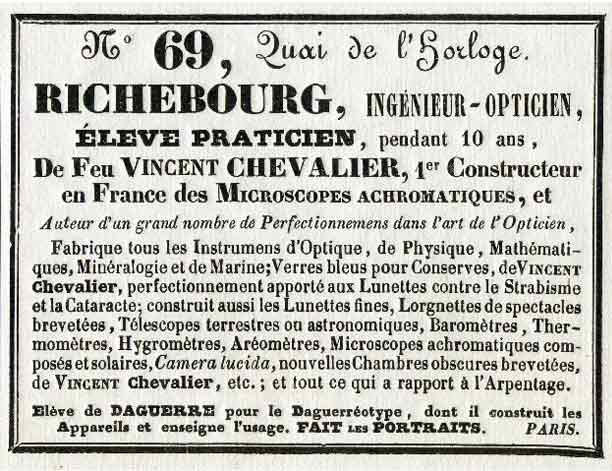
Figure 7.
An advertisement from Richebourg, stating that he had studied with Vincent Chevalier for 10 years.
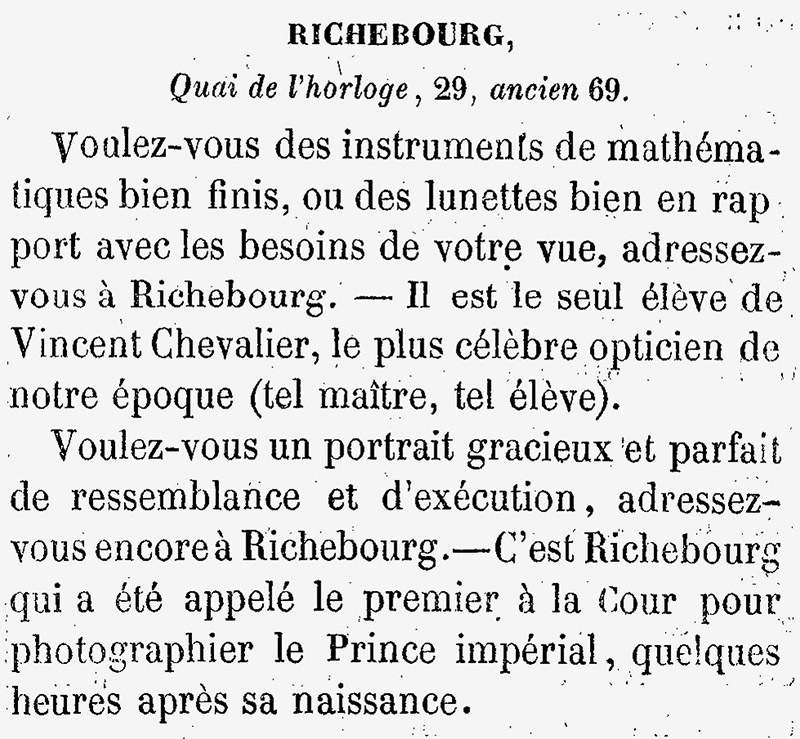
Figure 8.
An 1858 advertisement from Richbourg, “Do you want well finished mathematical instruments, or glasses well suited to the needs of your vision, contact Richebourg. He is the only pupil of Vincent Chevalier, the most famous optician of our time (like master, like pupil). Do you want a gracious and perfect portrait of resemblance and execution, address yourself to Richebourg. Richebourg was the first to be called to court to photograph the Prince Imperial, a few hours after his birth”. From “Le Journal des Propriétaires”.

Figure 9.
A camera lens by Richebourg. His interest in photography makes it highly likely that Richebourg manufactured this lens. The address of 29 Quai de l’Horloge indicates production after 1850. Adapted for nonprofit, educational purposes from www.antiq-photo.com/en/collections/museum/cameras/chambre-a-tiroir-francaise-richebourg-1-4-de-plaque
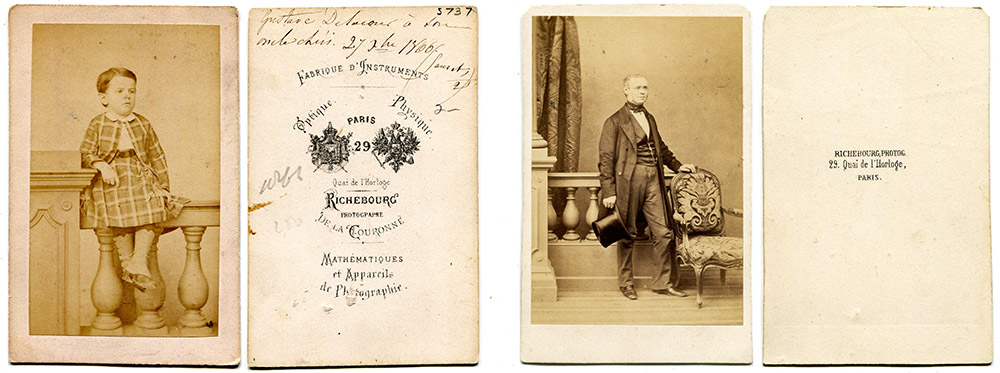
Figure 10.
Two cartes-de-visite photographs by Richebourg, both of which bear his post-1850 address of 29 Quai de l’Horloge.
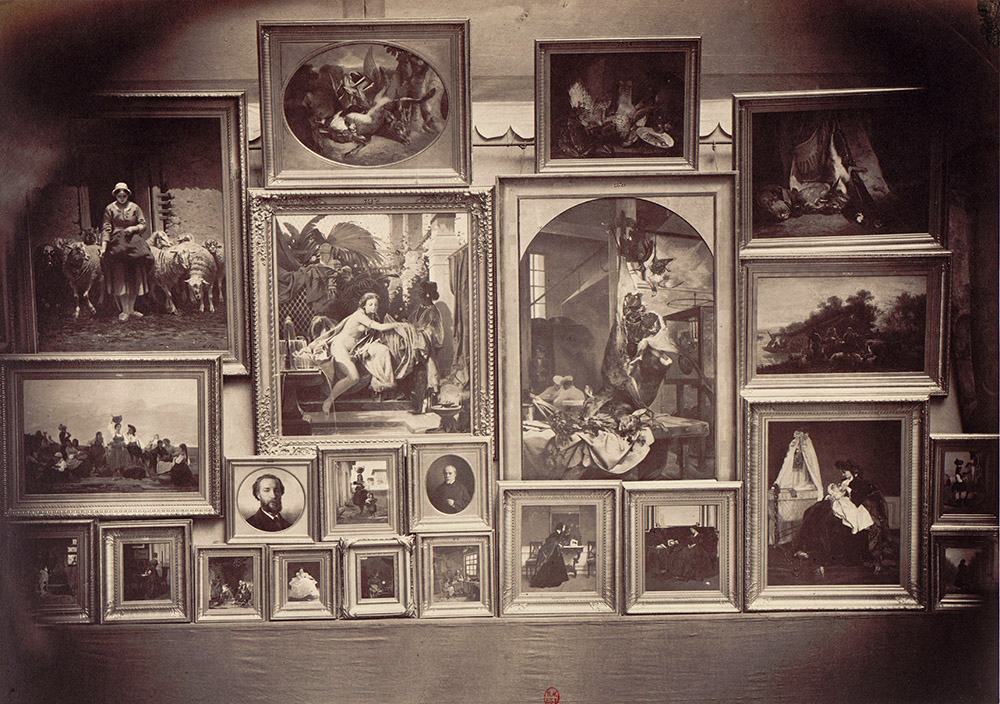
Figure 11.
“Hall des sculptures et cimaises du salon de 1861”, by Pierre Ambroise Richebourg. Adapted for nonprofit, educational purposes from commons.wikimedia.org
Acknowledgements
Thank you to the owners of histoiredumicroscope.com and microscope-antiques.com for permission to share images from their collections, and to Joe Zeligs for many insightful discussions.
Resources
Annuaire Général du Commerce, de l'Industrie, de la Magistrature (1847) Richebourg, pages 399 and 540
French vital records, accessed through ancestry.com
de Latreille, Edouard (1858) Repertoire General de Photographie, Rodet, Paris, page 446
Le Journal des Propriétaires (1858) Advertisement from P.A. Richebourg, February 5 issue, page 4
Molteni et Cie (1859) De Machines et Instruments de Précision, Catalogue et Prix Courant
Nachet et Fils (1856) Catalogue Descriptif des Instruments de Micrographie
Rapport du Jury Central sur les Produits de l’Industrie Française (1844) Mentions Favorables, page 492
Record of the inventory of the estate of Vincent Chevalier (1841) accessed through www.siv.archives-nationales.culture.gouv.fr
Record of the lease of 20 Quai de l’Horloge to Pierre Ambroise Richebourg (1850) accessed through www.siv.archives-nationales.culture.gouv.fr
Record of the inventory of the estate of Rose Séraphine Mollier-Gozé (1865) accessed through www.siv.archives-nationales.culture.gouv.fr
Record of the inventory of the estate of Pierre Ambroise Richebourg (1875) accessed through www.siv.archives-nationales.culture.gouv.fr
Richebourg, P.A. (1843) Nouveau Manuel Complémentaire Pour l'Usage Pratique du Daguerréotype, Richebourg, Paris
Richebourg, P.A. (1853) Nouveau Manuel de Photographie sur Collodion, Richebourg, Paris
Vapereau, Gustave (1858) Dictionnaire Universel des Contemporains, Hachette, Paris, page 1468










